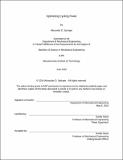Optimizing cycling power
Author(s)
Springer, Alexander D
DownloadFull printable version (950.4Kb)
Other Contributors
Massachusetts Institute of Technology. Department of Mechanical Engineering.
Advisor
Anette Hosoi.
Terms of use
Metadata
Show full item recordAbstract
In this study we determine a viable bioenergetic model for power allocation during a cycling race. Various models have been proposed to address power allocation in races with two models rising above others: the Morton-Margaria Three Tank model and the Skiba Energy Balance model. The energy balance model was implemented in MATLAB and compared against the gold standard implementation in Golden Cheetah to model the depletion of an athlete's energy over the course a ride. The implementation of the model was successful as verified by ride data from a cyclist in the 2014 Tour de France. Additionally, the model was further tested with sample power profiles in order to understand the depletion of energy over the course of a ride. Two key findings emerged from the investigation. First, we require a better account of exhaustion in the energy balance model which can be achieved by weighting the time spent below critical power over the time spent above critical power. This is because a cyclist becomes more exhausted by efforts at higher power outputs compared to the recovery at an effort below critical power. Second, energy balance models should use a variable time constant as rides and races have highly variable recovery periods below critical power which affects the ability of an athlete to reconstitute their energy. Use of a variable time constant could address the weighting of efforts below critical power identified in the first finding as well.
Description
Thesis: S.B., Massachusetts Institute of Technology, Department of Mechanical Engineering, 2016. This electronic version was submitted by the student author. The certified thesis is available in the Institute Archives and Special Collections. Cataloged from student-submitted PDF version of thesis. Includes bibliographical references (page 29).
Date issued
2016Department
Massachusetts Institute of Technology. Department of Mechanical EngineeringPublisher
Massachusetts Institute of Technology
Keywords
Mechanical Engineering.